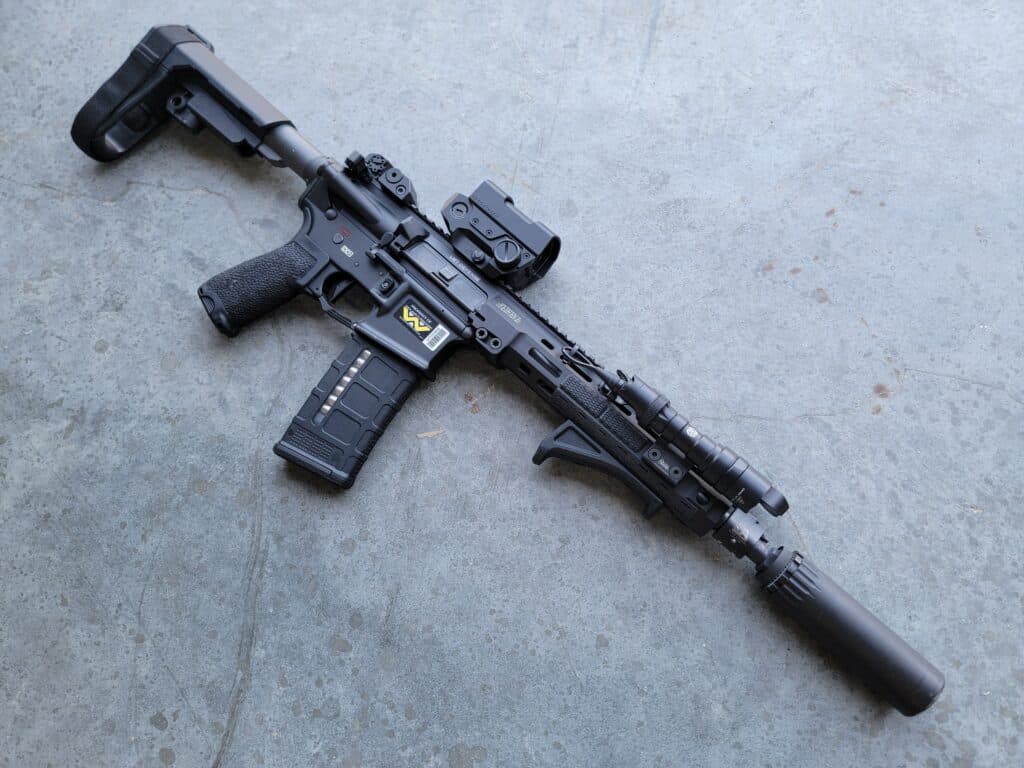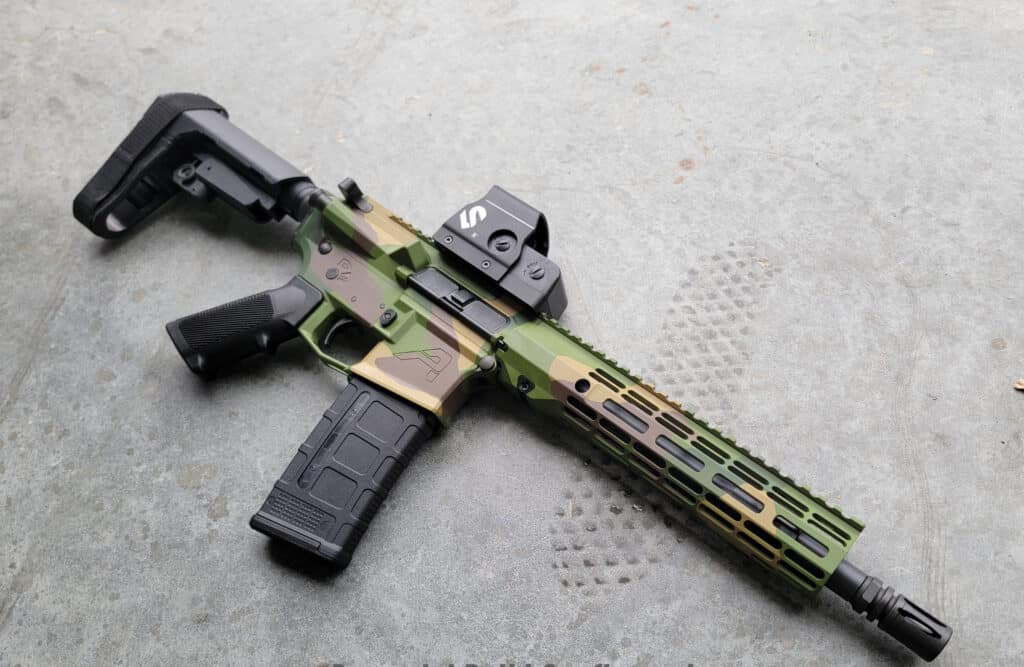The best part about Eugene Stoner’s design is the modularity of the design. It is a surprisingly simple design, yet robust, reliable, and accurate. Since it is so simple to modify and change parts, about every configuration you can think of has been tried on it at least once:
Ineffective, ultra-long barrels? ☑️
Super-stubby PDW barrels? Say goodbye to your eardrums, but yes.
And everything in between. The standard M4 barrel is a milquetoast 14.5” and A2 profile barrels are even longer at 20” Are they effective? Yes. Is 20” excessive? Also yes. You can have a highly effective carbine with a barrel length under 16 inches. But where is the sweet spot? Let’s take a look at the sub-16” crew and figure this out.
Let’s Talk Short Barrels
For the sake of simplicity in this article, we’ll assume that you are either using this as a pistol or are getting a tax stamp to make an SBR. I’ll refer to it generally as a rifle or carbine; you worry about the legality of your build.
An AR-pattern rifle with a sub-16” barrel makes for a highly compact weapon system. For comparison, my no-frills AR-15 with a standard Magpul MOE stock and 16” barrel with an A2 flash hider is exactly 32.5” collapsed.
A similarly configured SBR with a 10.5” barrel and A2 flash hider is only 27” long collapsed. The big question though is whether or not configurations like these can do three key functions:

- Provide an adequate range. How far can you count on a short barrel to effectively engage a threat?
- What is the impact on ballistics? How detrimental is it to use a short barrel on an AR-15, and what is the optimal barrel length for .223/5.56mm?
- What impact does a short barrel have on reliability?
Short Barrel Ballistics
Special thanks goes out to our friends at ballisticsbytheinch.com; you did the Lord’s work.
It is common knowledge that your ballistics will drop off as the length of the barrel is shortened. The converse is that there is a point of diminishing returns where a barrel longer than optimal has diminishing returns. The added length doesn’t do much to add range, velocity, or accuracy.
Also, because of overall fragmentation, ballistics, and reliability issues we’re only looking at 10.5” barrels and up. Also, we’ll use the 16” barrel as a baseline for performance, using 55-grain FMJ training loads. BBTI puts the muzzle velocity at 2,961fps, and muzzle energy around 1,050ft/lbs.
10.5” Barrels
A 10.5” barrel is a good place to start. It makes for a highly compact SBR or pistol. How does it stack up ballistically?
- Muzzle velocity: you’re looking at 2,616fps, which represents a 13.2% decrease from the 16” test length.
- Muzzle energy: about 820 ft/lbs. This is a substantial departure from a 16” barrel, roughly 28% lower.
Muzzle energy is important, but fragmentation is king. To be frank, losing 28% of your muzzle energy is a significant drop that will impair the stopping power of the rifle. However, the velocity required to reliable tumble and fragment is around ~2,500fps, which a 10.5” barrel provides. Is 820 ft/lbs still respectable? Absolutely. It’s about double that of a 147-grain 9x19mm from a 10” barrel.

11.5” Barrels
Adding an inch increases your overall length only slightly, and only goes up to 2,670fps over the 2,616fps recorded on the 10.5” barrel. Muzzle energy is also only slightly higher, about 880 ft/lbs or so. Again, there are a thousand variables that impact the performance of a given weapon with a given cartridge, so these are estimates at best.
The real advantage of the 11.5” barrel over the 10.5” is dwell time, which we’ll dig into shortly.
12.5” Barrels
A 12.5” barrel is a great compromise. It provides an overall rifle length that is 3.5” shorter than a standard 16” rifle, with ballistics that are not dramatically reduced.
The muzzle velocity of a 12.5” barrel is only reduced by about eight percent from the 16”, and muzzle energy is roughly 14% less than a 16” barrel.
The 12.5” barrel provides the best combination of velocity, energy, and dwell time increase of the short barrels talked about here while providing a substantially smaller overall weapon size.
A 12.5” barrel may well be the ultimate all-around barrel length when you’re using self-defense ammunition or M193; it provides adequate muzzle velocity to promote fragmentation with the SD ammo, while still allowing the M193 to tumble and fragment effectively.
What Is ‘Dwell Time?’
Dwell time is technically defined as the amount of time cartridge gasses spend pressurizing the gas system. The timing is measured when the bullet pass the gas port, but before exiting the barrels.
The dwell time on a pistol-length gas system is much higher than a carbine or mid-length gas system, but that translates into less energy being behind the bullet. The gas system must absorb a ton of pressure and you get less energy and velocity from the bullet.
Every increase in barrel length and gas system length decreases dwell time, which increases the overall reliability of the weapon. It also makes the weapon less picky about different ammunition types and pressures and is more forgiving to physical factors like temperature.
The distance of the gas block to the chamber helps with bolt unlock speed.
When a primer ignites the powder, the brass casing expands due to heat and has significant surface contact/friction with the chamber while the projectile is being discharged. By delaying when the bolt unlocks and removes the casing, you allow the casing to cool and shrink down slightly for a smoother extraction. This increases component life by reducing wear on the (already) hot springs and contact components.
A longer gas system also maximizes velocity before the casing is yanked. More powder is burned before you give the propellant a new exit out of the chamber, instead of out of the muzzle. You also get less unburnt powder in the action, which can add grit to the system.
Hence, midlength > carbine when possible.
Bottom line: dwell time has a direct impact on the overall reliability of a rifle. The dwell time of the rifle is determined by the distance that the gas port is from the chamber. A carbine-length system will always have a higher dwell time than a mid-length system, and will also have much higher operating pressures, which can lead to over-gassing. But that’s a topic for another time.
Wrapping Up
It’s hard to build a primer on short barres without getting lost in the weeds. Short barrels have inherently longer dwell times, lower velocity, and lower muzzle energy. These are the tradeoffs for a compact weapon system. There are always concessions when you reduce barrel lengths in an AR-15. Personally, we feel that the 12.5” barrel with a carbine length gas system presents the best overall compromise between compact dimensions and performance.
Also, be on the lookout for our forthcoming article on barrel lengths that don’t require tax stamps!

I have heard conflicting reports for the velocity at which 55 gr rounds tumble and fragment, but 2,500 seems lower than most, it seems like 2,600 or sometimes 2,700 fps is more frequently cited, which puts 10.5″ barrels in a spot that seems iffy at best. Do you know of any decent sources for the 2,500 number? In any case, good article, I would tend to agree that 12.5″ is the best option if going for a shorter barrel.
I know this may sound kinda be off topic, but it is about barrel length.Why is it, that when it come to barrel length, that it is measured in an awkward size? (for example 12.5″, 12.7″, 13.7″, 13.9″), barrel lengths. Instead of just using standard one inch increments? (for example 12″, 13″, 14″, 16″ etc.) plus why no 15″ barrel? 1 inch is one inch. With a carbine barrel length to reach a minimum of 16″ inches to be legal, without having to pay a tax stamp. Wouldn’t a 15″ barrel seem more logical with a pinned & weld muzzle device. Especially in today’s advancement with barrels, and muzzle devices that have exterior threads. I know I am not that smart to begin with, and I am for dang sure not an rocket scientist or engineer, but these question have always eluded me, and nobody seems to have an answer. yeah I know there is some things that are done for cost savings and overhead, and twist rates don’t add up to a hill of beans, when it come to awkward barrel lengths. if anybody has these answers, I would gladly listen. long as it is explained in laymen’s terms such as barrel lengths for dummies… lol God Bless Y’all & the 2nd Amendment
Good write up, with one tiny quibble. I wonder if you meant to say 12.5″ with mid-length, not carbine-length gas, for the best compromise?